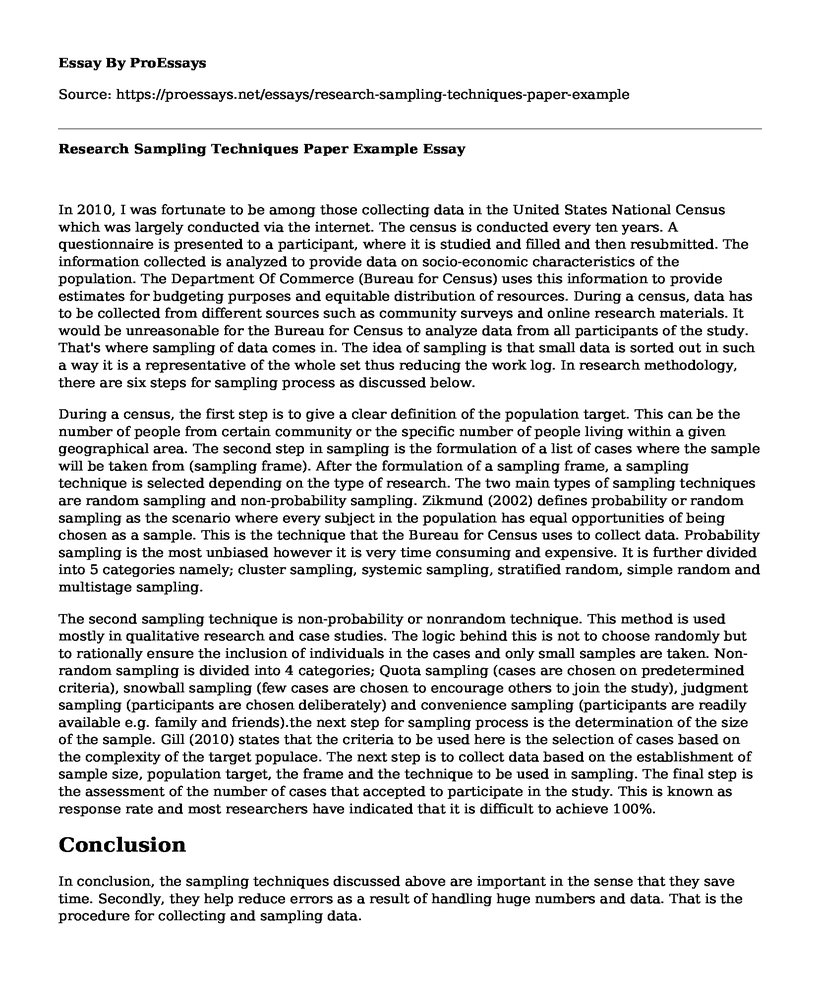In 2010, I was fortunate to be among those collecting data in the United States National Census which was largely conducted via the internet. The census is conducted every ten years. A questionnaire is presented to a participant, where it is studied and filled and then resubmitted. The information collected is analyzed to provide data on socio-economic characteristics of the population. The Department Of Commerce (Bureau for Census) uses this information to provide estimates for budgeting purposes and equitable distribution of resources. During a census, data has to be collected from different sources such as community surveys and online research materials. It would be unreasonable for the Bureau for Census to analyze data from all participants of the study. That's where sampling of data comes in. The idea of sampling is that small data is sorted out in such a way it is a representative of the whole set thus reducing the work log. In research methodology, there are six steps for sampling process as discussed below.
During a census, the first step is to give a clear definition of the population target. This can be the number of people from certain community or the specific number of people living within a given geographical area. The second step in sampling is the formulation of a list of cases where the sample will be taken from (sampling frame). After the formulation of a sampling frame, a sampling technique is selected depending on the type of research. The two main types of sampling techniques are random sampling and non-probability sampling. Zikmund (2002) defines probability or random sampling as the scenario where every subject in the population has equal opportunities of being chosen as a sample. This is the technique that the Bureau for Census uses to collect data. Probability sampling is the most unbiased however it is very time consuming and expensive. It is further divided into 5 categories namely; cluster sampling, systemic sampling, stratified random, simple random and multistage sampling.
The second sampling technique is non-probability or nonrandom technique. This method is used mostly in qualitative research and case studies. The logic behind this is not to choose randomly but to rationally ensure the inclusion of individuals in the cases and only small samples are taken. Non-random sampling is divided into 4 categories; Quota sampling (cases are chosen on predetermined criteria), snowball sampling (few cases are chosen to encourage others to join the study), judgment sampling (participants are chosen deliberately) and convenience sampling (participants are readily available e.g. family and friends).the next step for sampling process is the determination of the size of the sample. Gill (2010) states that the criteria to be used here is the selection of cases based on the complexity of the target populace. The next step is to collect data based on the establishment of sample size, population target, the frame and the technique to be used in sampling. The final step is the assessment of the number of cases that accepted to participate in the study. This is known as response rate and most researchers have indicated that it is difficult to achieve 100%.
Conclusion
In conclusion, the sampling techniques discussed above are important in the sense that they save time. Secondly, they help reduce errors as a result of handling huge numbers and data. That is the procedure for collecting and sampling data.
References
Zikmund, W. G., Babin, B. J., Carr, J. C., & Griffin, M. (2002). Business Research Methods. South.
Gill, J., & Johnson, P. (2010). Research methods for managers. London: SAGE Publications.
Cite this page
Research Sampling Techniques Paper Example. (2022, Oct 25). Retrieved from https://proessays.net/essays/research-sampling-techniques-paper-example
If you are the original author of this essay and no longer wish to have it published on the ProEssays website, please click below to request its removal:
- Disconnection by Channel
- The Great Man Theory Essay
- Essay on Strategic Planning Increases Productivity and Retention at New Belgium Brewing Co
- Essay Example on Redesigning Healthcare Workflow for Improved Efficiency
- Tardiness in Event & Clock Time Cultures - Report Example
- Leadership Models - Research Paper Example
- Social Innovation - Report Example







